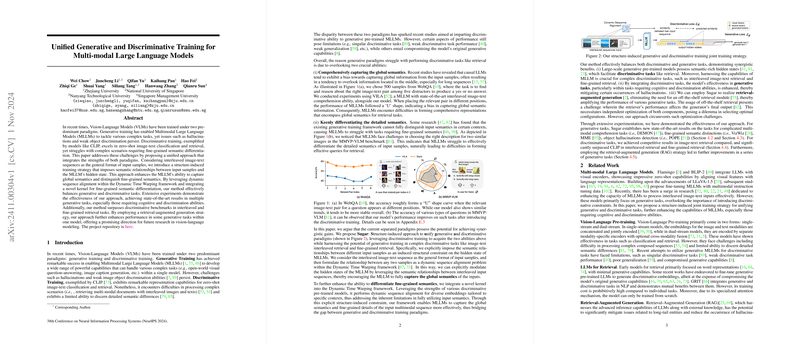Unified Generative and Discriminative Training for Multi-modal LLMs
The paper "Unified Generative and Discriminative Training for Multi-modal LLMs" proposes a hybrid approach to improve the functionality of Vision-LLMs (VLMs) by synthesizing generative and discriminative training strategies. VLMs traditionally adopt either a generative or a discriminative paradigm. Generative models, often typified by Multimodal LLMs (MLLMs), excel in handling complex tasks such as visual question answering and image captioning but suffer from issues like hallucinations and weaker object discrimination. Discriminative models, exemplified by CLIP, display robust capabilities in zero-shot classification and retrieval yet falter in detailed semantic differentiation.
This research attempts to bridge the efficacy gap between these two paradigms by integrating their strengths. Through the lens of interleaved image-text sequences, the authors propose a structure-induced training strategy intended to enhance an MLLM's semantic grasp and discrimination capabilities. By utilizing a dynamic sequence alignment framework, structured as Dynamic Time Warping, along with a novel kernel, the paper claims notable improvements in parsing interleaved and fine-grained multimodal content.
The technique theoretically and empirically supports the proposed dual capability by highlighting state-of-the-art performances across generative and discriminative benchmarks. Extensive experiments reveal notable successes in complex multimodal generative tasks and nuanced retrieval tasks, evidencing the practical applicability of the unified model's cognitive capabilities.
The research further navigates the benefits of retrieval-augmented generation within the MLLM framework, circumventing the need for specialty retrieval modules and optimizing performance across generative tasks. This suggests a cohesive path forward for vision-LLMing that harmonizes generation and discrimination within a singular framework.
Future research based on this work might explore further refinements in balancing generative and discriminative paradigms, integration of improved sequence alignment techniques, and optimized kernel functions for enhanced semantic modeling. Given the documented improvements and capacity to offset previous limitations, this hybrid generative-discriminative strategy presents a promising avenue for future enhancements in VLMs.
